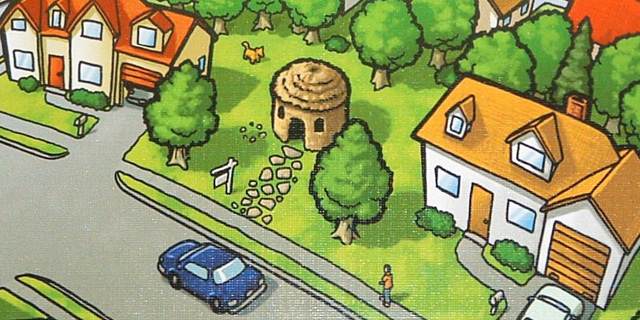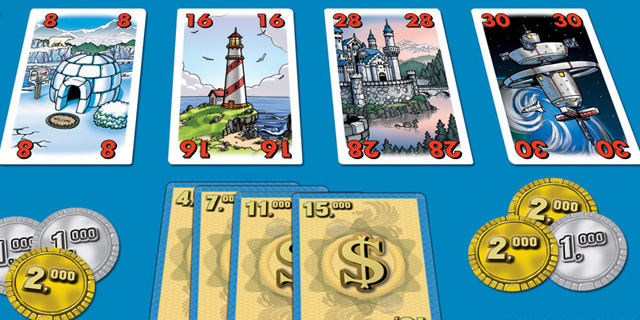
Simple fillers are some of the best gaming values around, and they don’t get much simpler than Stefan Dorra’s 2008 classic For Sale (published by Gryphon Games). The instructions literally take up a mere three pages, and a game can fly by in less than half an hour, but the fun had in that time can be disproportionately immense.
Each player begins with a hidden supply of cash with which they will purchase various Property cards via auction. These Properties are cards numbered from one to thirty, depicting a range of real estate ranging from a cardboard box all the way up to a space station with just about every conceivable dwelling in between. Each round a number of these cards equal to the number of players is turned over, and whoever won the last bid gets to declare an opening bid (or pass). Each subsequent player can either raise the bid or pass. As each player passes, they claim the lowest-valued Property available, but if they had previously made a bid that round they must forfeit half of that bid, rounded up. Once everyone else has passed, the remaining player pays their full bid and takes the highest-valued Property. This process repeats until all of the Property cards have been claimed.

You don’t get a lot of starting cash, so you have to be shrewd in your bidding to make your initial investment last the entire phase. If you run out of cash you will still get new Properties, but they will be the bottom of the barrel each time as you will be forced to pass. Depending on the deal each round that might not be so bad, and anything you manage to claim for no cash is probably bound to turn some sort of profit in the next phase.
To set that phase up, the thirty Currency Cards are shuffled. These cards are valued in $1,000 increments with two each ranging from $2,000 to $15,000… plus two cards worth zero. As in the Properties phase, a number of these Currency cards equal to the number of players are turned up. Each player selects one of their Property cards, then they are revealed simultaneously. Whoever offered the highest-valued Property wins the highest-valued Currency and so on down the line. This repeats until all of the Currency cards are claimed (and all of the Property cards thus spent), and whoever has the highest value (plus any leftover cash from the Properties phase, which is also the tiebreaker) wins.
Knowing what Properties your opponents have claimed is crucial here, as you have to try and estimate how highly they will value the available Currencies and guess what Properties they will offer. Again, the range of cards dealt will also influence your decision, especially if you have some low-value Properties you need to unload. You have to be especially careful when one of the zeros shows up, as you definitely don’t want to throw away a decent Property for nothing!

As with most fillers, the randomness is part of the charm in For Sale. You never know what cards will show up each round. This is especially true when playing with three or four players, which requires some cards to be randomly removed from each deck before playing. Being able to evaluate the relative values of cards in both phases on the fly is the core of the game, but the player interaction is what keeps things interesting. The Properties phase is basically a giant game of chicken, and those who “blink” too late could be penalized severely while still winding up with a suboptimal card (and possibly more after that if they keep getting outbid). Meanwhile, the Currency phase is all about reading your opponents and trying to best position your Property amongst what they are likely to offer up. Keeping the current live “trump” (highest-valued Property) in mind is also important, as whoever holds that can outright claim the round they think is worth it the most.
For Sale accommodates from three to six players, and as mentioned will almost never take more than 30 minutes per complete play. At a retail price of around $25, it doesn’t take long for that to earn its keep several times over. The recommended age is eight and up, but any kid with a working grasp of what number is bigger than the other should be able to play just fine.



















